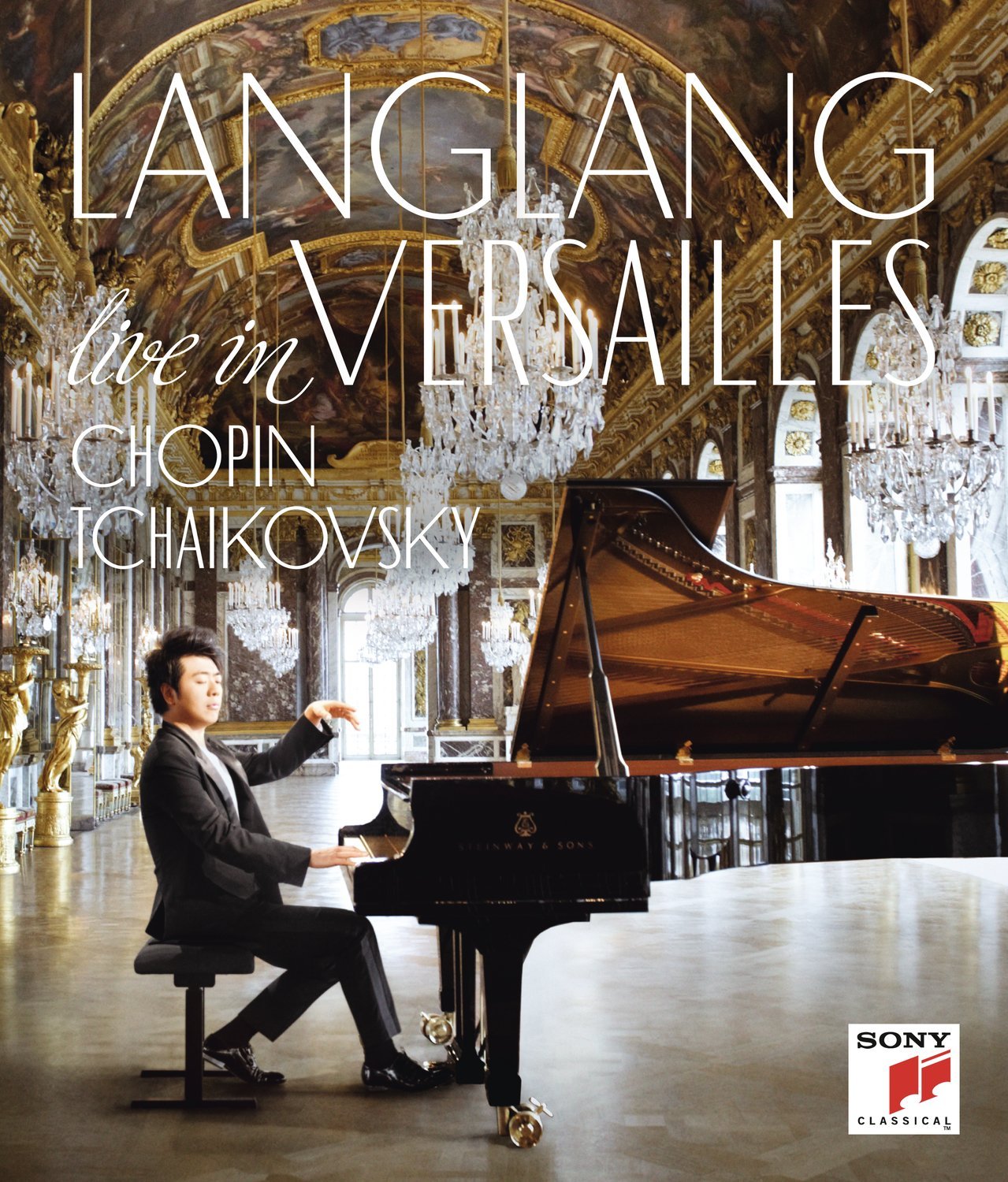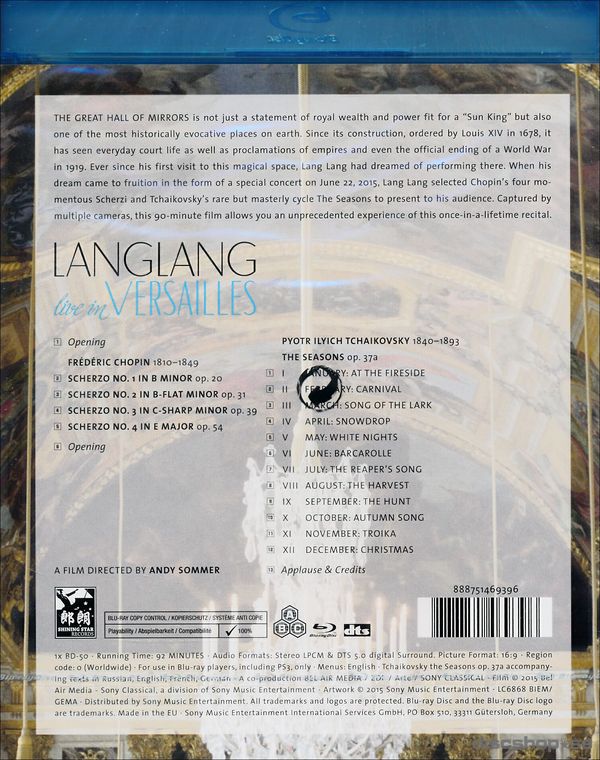

Lang Lang Live in Versailles, a piano recital by Lang Lang, features the following:
Chopin Scherzo No. 1
Chopin Scherzo No. 2
Chopin Scherzo No. 3
Chopin Scherzo No. 4
Tchaikovsky The Seasons
The Tchaikovsky The Seasons should have been called The Months. Here are the 12 short pieces in The Seasons:
January: "At the Fireside"
February: "Carnival"
March: "Song of the Lark"
April: "Snowdrop"
May: "White Nights"
June: "Barcarolle"
July: "The Reaper's Song"
August: "The Harvest"
September: "The Hunt"
October: "Autumn Song"
November: "Troika"
December: "Christmas"
Performed 2015 in the Hall of Mirrors at the Palace of Versailles. Directed for TV by Andy Sommer; produced by François Duplat. Released 2015, disc has 5.0 dts-HD Master Audio sound output. Grade: A-
This private recital was recorded on June 22, 2015. It was released less than 4 months later, and I got my copy on November 8. That's called shortening the supply chain. This makes producing a Blu-ray disc almost seem like journalism. It reminds me of the movie newsreels when I was a kid in World War II: there would be a big battle in the Pacific; and in just a few months, you could see motion picture clips of the battle at the movie house in your little town—sometimes in color!
There are no extras on the disc. Bravo! The keepcase booklet has only 6 pages. But that's all you need, and the artwork is gorgeous. This should be a good seller for Sony this holiday season. Sony PR says this performance was "captured in 4K." The 2015 Blu-ray is a "2K" product, and there is also a DVD. Maybe one day we will also get a 4K version released and we will be able to compare the same show in 1K (also called DVD), 2K, and 4K.
The Chopin Scherzi
Per the keepcase booklet, it's thought that both Chopin and Tchaikovsky visited Versailles. This was enough inspiration for Lang Lang to rent the Hall of Mirrors as the venue for this recital:
A bit of local color:
Lang Lang built a small stage in about the center of the long room. Below he bows at the beginning of the program. A gutsy decision was to do this during daylight, which puts the TV director at the mercy of the weather, as we shall see. (The only HDVD made previously at the Hall of Mirrors was the Mission concert by Cecilia Bartoli—she recorded at dusk and by "candlelight.")
Below we see the live studio audience. There were 10 files of simple folding chairs and about 14 ranks for maybe 140 spectators, all dressed to kill. I think everybody seated had some special connection to Lang Lang or the project. If they accepted the invitation, I think they took on the obligation to sit through multiple retakes without leaving any seat empty. In the picture below you can see 4 lean, white pylons supporting spotlights shining down on the piano. There were 5 camera operators plus a team of 2 on a steadycam. (Most of the operators were women, but I'll just refer to "cameramen.") You can spot 4 cameramen in the image below, and another was, I presume, taking this picture. But you will rarely see them again in the rest of the video:
Only one guy made it to the front row. This is a weak shot, but it's the only one to show all the front-row ladies:
In glorification of his main subject, TV director Sommer used relatively shallow depth-of-field-of-focus for much of his video:
But in the next 2 shots, all magnificent, Sommer well captures the barbaric grandeur of Versailles. I want to see this later in 4K:
Next is my favorite shot from the whole video, which is now the wallpaper on my main computer:
Sommer gives us a vast variety of angles and views within this rather narrow and constricted space. How did he do this while keeping his cameramen out of the pictures? For example, in the shot below, Lang Lang sits with his back to the mirrors looking toward the windows. The angle is perfect. You can't see the cameraman in the mirrors:
And just a moment later we get the view below from behind Lang Lang looking out the windows. What happened to the cameraman that was there just a moment ago shooting towards us? Did he artfully squat to hide behind the piano? Or did Sommer shoot multiple times with the cameramen all aiming in the same direction each time? That would allow the editor to splice clips and magically eliminate the pesky cameras:
I couldn't resist the view below of our hero during a slow passage:
There are many excellent shots of finger work at the keyboard:
A dramatic accent!
And as Scherzo No. 4 winds down, it appears it is raining outside:
The Chopin Scherzi are among the grandest of piano war-horses. I vividly remember listening to them over and over during my Chopin phase of life. The first time I watched this Lang Lang version, I kept remembering how Arrau and others played them differently on CD, and Lang Lang's opening runs in Scherzo No. 1 sounded rough to me. But after watching Lang Lang a couple of times, I found his interpretations had replaced my memory of those of yesteryear. That's because I'm an amateur piano fan. But then I read a review of this (in its CD version) by Jeremy Nicholas, a piano expert with Chopin scores on his shelf, in the October 2015 Gramophone (at page 63). Nicholas asserts that Lang Lang deviates from the scores in a number of ways and plays the Scherzi not as Chopin wrote them but as Lang Lang thinks Chopin should have written them. For example, Nicholas asks, "Why make the skittering opening passage work [in Scherzo No. 1] so incoherent?" Well, that's the roughness I noted, but couldn't articulate. Nicholas goes on to say that many other recorded pianists play the Scherzi "more appealingly."
Tchaikovsky's The Seasons
The Seasons by Tchaikovsky is, per the keepcase booklet, under-appreciated and rarely recorded by major talents. Of the 12 short pieces, you might well be familiar with the "Carnival" (February) and the "Barcarolle" (June), which are popular encores. There are many CDs available, but Lang Lang is the first pianist to make a video of The Seasons. Each piece is matched to a short poem in Russian. Subject title has translations of each poem in English, French, and German. For example:
The "Barcarolle" poem in French:
Now in English:
And finally in German:
All 12 miniatures are charming, and Lang Lang delights in them:
Most of the pieces are simple and slow compared to the Chopin Scherzi. So now we see again the sensitive and introspective side of Lang Lang that was so evident in his Dragon Songs HDVD. When the slower pace allows it, we see that Lang Lang expresses his emotions in the movements of his hands and even the individual fingers:
More local color:
This video was made in June. The day was part sunny and part cloudy with, I think, a shower or two. As the weather changed, so did the light streaming into the Hall of Mirrors. Sommer and his crew were working hard to film the recital while staying out of sight. And then the light kept changing on them! I'm sure they did their best to adjust gear on the fly, and editor Carl Plötzeneder worked wonders with damage control. But even so, some striking inconsistencies appear in the video. Below are 2 pairs of screenshots taken from The Seasons. In each pair, you first see a "gray" image made, I think, while it was raining and then another "golden" image taken while sun was shining. On some occasions in the second half of the video, the gray and golden images appears within seconds of each other in a manner that is disconcerting. This is a risk you run when you shoot a concert on one day in the summer using natural light:
Enough about the video. The SQ is excellent with close, clear, and authentic piano sound coupled with dramatic dynamic range.
How does Lang Lang's performance of this music stack up? There are 100 to 150 recordings (including DVDs) of each scherzo on the market with renown versions by giants of the past like Artur Rubinstein, Arturo Michelangeli, and Krystian Zimmerman. At least one piano expert is on record saying that Lang Lang's performance falls short of historic milestones. So let's assume a panel of experts would give Rubinstein and others an A+ and Lang Lang a B for their performances of the Scherzi. But how many of the legacy versions were recorded at 48kHz/24-bit sampling rates and enjoy lossless sound output? None. How many legacy version have video? Maybe 5. And of these, how many are in color and high-definition. None. And how many videos were made in a spectacular palace? Probably none. So which of these recordings would have the greatest appeal to the general market of amateur classical music fans? Based on this line of thought, I would say that subject HDVD can justly be considered among the best recordings ever of the Scherzi.
And what about The Seasons? Jeremy Nicholas complains about the "banality" of many of the "months" in the cycle. That's the bad side of being an expert—picky, picky, picky! If you are a typical amateur piano fan, you will probably enjoy seeing and hearing Lang Lang play all of them and be charmed as I was by the music and the little poems. So looking at the available recordings of The Seasons, I would suggest that subject title is this respect in a superior class all by itself.
Time for a grade. On account of the controversial performance of the Scherzi, the lighter weight of The Seasons, and the video difficulties noted, I'll give this HDVD an A-. If you really know your Chopin, you probably would find the A- too high.
OR





























